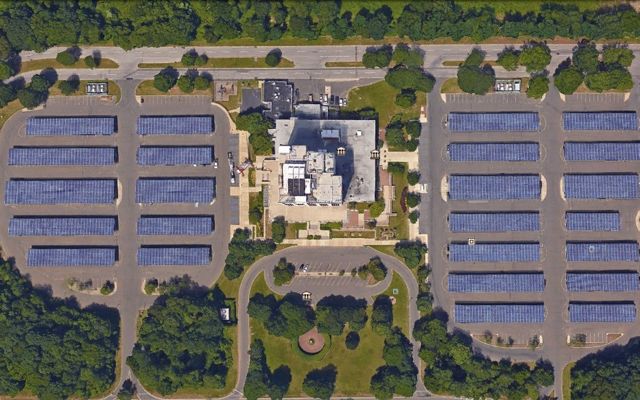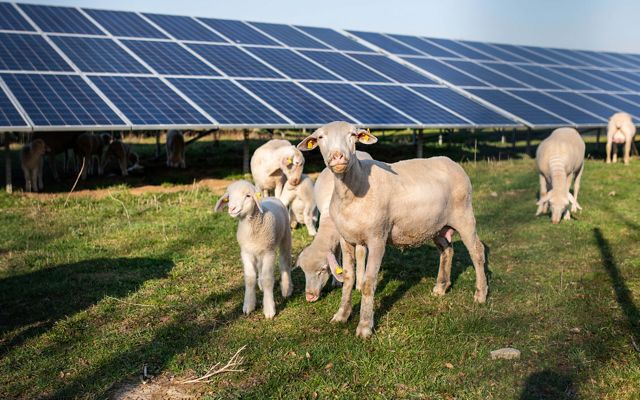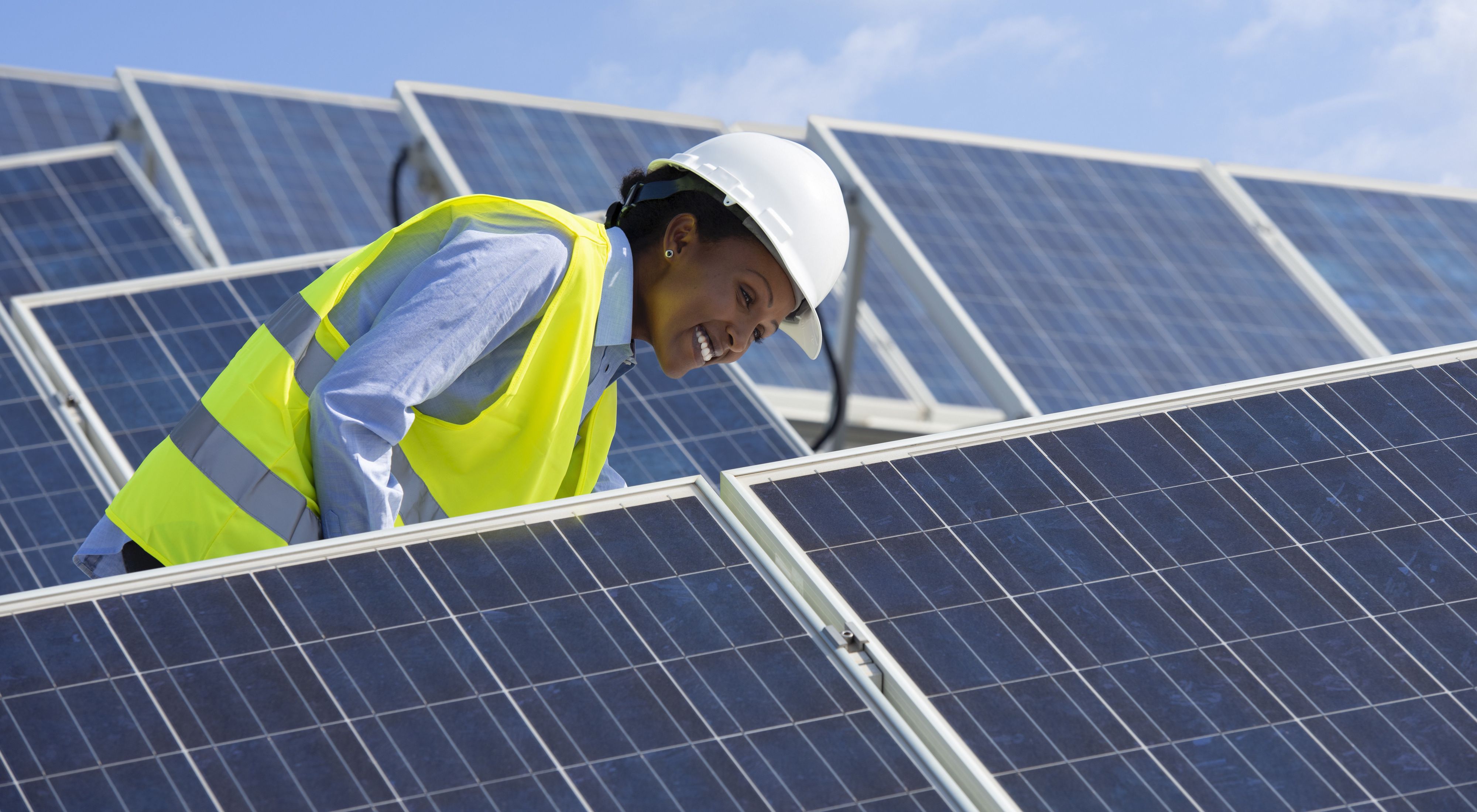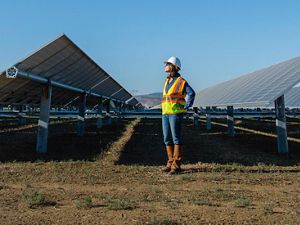Roadmap to a Solar Energy Future on Long Island
A new report details how to advance clean energy development while safeguarding the places people value most.
As seen from above, the solar carport at the H. Lee Dennison Building in Hauppauge, Long Island, twinkles in the sun. Since 2011, the solar canopies there, laid out in rows above the parking spaces, have generated shade in the hot summer months and carbon-free electricity all year round, along with a multitude of other benefits: improved air quality and improved public health; jobs that pay above the national average; reductions in greenhouse gas emissions; and income for Suffolk County, which has leased the parking lot to the array’s developer.
The even better news about this solar project and ones like it—mid-to-large-scale arrays of at least 250 kilowatts—is that they can play a pivotal role in meeting New York State’s nation-leading climate and clean energy goals. In fact, these arrays, also called commercial- and industrial-scale solar, have the potential to generate more electricity than Long Island uses each year—enough to power 4.8 million homes. And, according to a new report, they can do it without negatively impacting many of the places Long Islanders hold dear—the region’s farmlands and forests, its cultural heritage sites and open spaces.


The Long Island Solar Roadmap, available in both English and Spanish, explores how to advance solar development on the country’s most populated island while safeguarding the landscapes people value most and expanding access to clean energy, especially for low-to-moderate income residents and people of color. Funded by the Doris Duke Charitable Foundation, spearheaded by The Nature Conservancy and Defenders of Wildlife, and informed by a consortium of 38 local stakeholders, the Roadmap offers a first-of-its-kind online mapping tool that identifies areas for responsible solar development and lays out clear strategies for lowering barriers to the clean energy technology.
Quote: Jessica Price

This report shows that in scaling up solar, we don’t have to choose between one ‘green’ good—clean energy—and another—undisturbed forests, open spaces, and farmland....[W]ith the right approach, we have room for it all.
Mapping Opportunities for Solar Development
Like so much other work at The Nature Conservancy, this project got its start with the awareness of a problem. In 2016, several proposed large solar projects on Long Island were very publicly shot down because they would have required clear-cutting forests. “I was having lots of conversations with folks about where solar projects shouldn’t go,” says Jessica Price, The Nature Conservancy’s New York renewable energy strategy lead. “What I was really interested in talking about was where they should go.”

Long Island Solar Roadmap
Download the Report (English)To help figure that out, The Nature Conservancy and Defenders of Wildlife brought together utilities, municipalities, solar developers, commercial property owners, farmers and community groups to talk about what they valued and how those values could be used to inform decisions about solar siting. The team also undertook an ambitious effort to digitally map Nassau and Suffolk counties, creating new computer tools to identify the types of land that should be off-limits to solar development and the areas where solar could be prioritized.
What they found, Price says, was a major opportunity: “Even though we don’t have large swaths of undeveloped land on Long Island, we have plenty of parking lots, warehouse roofs, brownfields, capped landfills and other areas already impacted by development.” Support for solar sited in such places is plentiful, too. Public opinion research conducted as part of the project found that 92 percent of Long Islanders surveyed endorse the use of mid-to-large-scale solar, and the technology is especially popular when sited on parking lots and rooftops and when projects are developed and installed by local companies.
-
92%
The percentage of surveyed Long Islanders who endorse the use of mid-to-large scale solar.
-
700K
Installing one-quarter of the mapped solar opportunities could cut as much carbon pollution as removing this number of cars from Long Island's roads.
-
36
The number of lives saved, over 20 years, by installing solar on one-quarter of the areas mapped.
Ramping up Solar and its Many Benefits
The report also explores the impacts that scaling up solar could have on reducing carbon emissions and improving public health. Installing just one-quarter of the solar potential identified in the project could cut carbon pollution equivalent to removing more than 700,000 cars from Long Island’s roads. And over 20 years, that amount of solar could improve air quality enough to save 36 lives and prevent as many as 28 hospitalizations. Ramping up solar to that degree could also create thousands of local jobs and improve the access of low-and-moderate income residents and people of color to clean energy.
Now, Price and others will take the map on the road or, for the time being, to virtual meetings with local officials and others interested in advancing mid-to-large scale solar on Long Island. “Solar power offers incredible benefits,” says Price. “This report shows that in scaling up solar, we don’t have to choose between one ‘green’ good—clean energy—and another—undisturbed forests, open spaces, and farmland. Even on densely populated Long Island, with the right approach, we have room for it all.”
Mapping a Solar Energy Future on Long Island
The Long Island Solar Roadmap is here.



